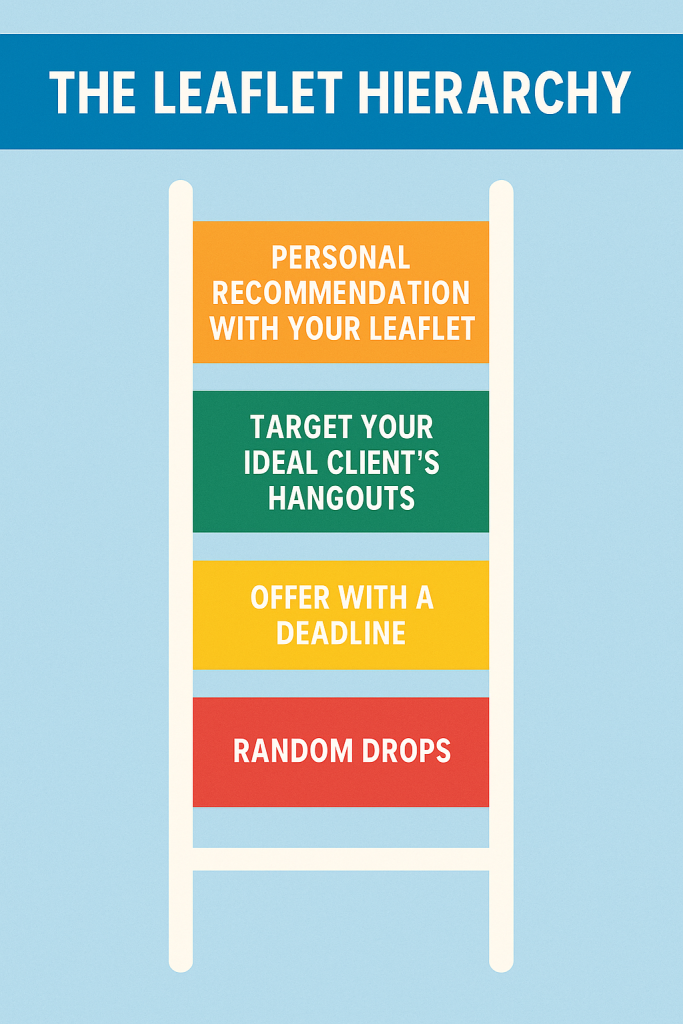The Leaflet Hierarchy: How to Get Clients From Leaflets
I’ve lost count of how many therapists have told me they’ve “tried leaflets” and decided they don’t work.
If you’re not sure what to actually put on your leaflet ( things like wording, offers, and layout ) I’ve written another post that walks you through it step-by-step.
You can read that here before diving into this one.
The Leaflet Hierarchy
Think of this like a ladder. The bottom rung is the easiest to do but brings the smallest return. The top rung takes more thought but delivers the best results. Aim for the top rung, and try to avoid the bottom rung!

Level 1 – Bad:
Random Drops
This is where you print a stack of leaflets and post them through doors or leave them in piles in random places.
It’s quick, it gets your name “out there” – but the response rate is usually tiny.
Because:
- You’re targeting everyone, not just your ideal client.
. - People often don’t read random leaflets.
. - There’s no personal connection or reason for them to act now.
It can work, but you’ll need to do a lot to see results ( think hundreds or thousands ) and it’s a full day’s job.
Level 2 – Better:
An Offer and A Deadline
If you’re going to hand out or leave leaflets somewhere, make them work harder! You need to give people a reason to book in and to a reason to do it soon – otherwise your lovely leaflet ends up in a drawer somewhere, forgotten about!
Two things make a huge difference:
- A special offer (e.g. “£10 off your first treatment” or “Buy 3 massages, get the 4th free”).
. - A time limit (e.g. “Offer valid until 30th September”).
Add these two things to your leaflets, flyers and business cards – it will really help!
Level 3 – Good:
Place them Strategically
Think about where your ideal client spends time – and put your leaflets there.
If you help:
- Desk workers → try putting them in coffee shops near offices, co-working spaces.
. - Sportspeople → try gyms, running clubs, yoga studios.
. - Parents → could try baby groups, play cafés, soft play centres.
By putting your leaflets where your potential clients already are, you make it more likely that they’ll notice you and be in the right mindset to book.
Level 4 – Best of all:
Personal Recommendation
This is where leaflets stop being “bits of paper” and start becoming powerful.
Here, you don’t just leave your leaflet – you give them to someone who then hands it directly to your potential client AND recommends you at the same time.
Examples:
- A yoga teacher says to their class, “If your shoulders are feeling tight after today’s practice, you should see [Your Name] — she’s amazing.”
. - A café owner says to a regular, “You’ve been complaining about your back – here’s the therapist I see.”
That endorsement is the answer. People are far more likely to book when the recommendation comes from someone they already know and trust.
So how do you get to this stage? It’s not complicated, but it does take a bit more effort than just dropping off leaflets and hoping for the best!
Think about who already sees the people you’d love to treat – yoga teachers, Pilates instructors, hairdressers, café owners. Don’t just hand them a pile of leaflets and hope. Go along to their class, pop in for a coffee, get to know them a bit first.
Once you’ve built some rapport, explain what you do and the kind of problems you help with, then offer them a few leaflets in case their clients mention it. Give them a small stack so it feels doable, thank them if they recommend you, and check in now and again so you stay fresh in their mind.
This strategy work so well because it’s a win for everyone. THEY get to look helpful by pointing their clients in the right direction, their CLIENTS get a help with their problem, and YOU get new people coming through your door!
How to decide where to put your energy
Start as high up the hierarchy as you have the time and energy for:
- Aim for Level 4 – get someone trusted to hand your leaflet directly to your ideal client. (make sure the leaflet ALSO includes level 2 – an offer and a deadline!)
. - If that’s not possible, aim for Level 3 – put them in the exact places your ideal clients spend time.
. - If you can add an offer + deadline, you’ve now hit Level 2.
. - Only do Level 1 if you have the time and stamina to deliver huge numbers, and you’re OK with a low return rate.
Getting the best results
Once your leaflets are out in the world, the job isn’t over. Here’s how to make sure they actually lead to bookings instead of sitting in a drawer or the recycling bin:
Before You Print – Test Your Message First
One of the biggest mistakes I see therapists make is printing leaflets before they know if the wording will work.
Before you spend money, test your message online:
- Share it on Facebook or Instagram.
. - Post it as an update on your Google Business profile.
. - Put it in your email newsletter if you have one.
If people respond with likes, comments, or questions – you know you’re on the right track. If they don’t, tweak it before sending it to the printer.
It’s an easy step AND saves you wasting money on a beautiful, but ineffective, leaflet!
Make sure you track it!
You won’t know what’s working unless you measure it.
- Add a unique code or phrase to your leaflet (e.g. “Mention this leaflet for £10 off”).
. - Keep notes of how many new bookings come from each location or referrer.
. - Drop the places that don’t bring results and double down on the ones that do.
Quick-Win Challenge for This Week
Don’t overthink it – just try this:
Give 10 leaflets to people who can personally recommend you to their clients or friends.
Do it in the next 7 days.
See if you get bookings or at least new enquiries!
Leaflets and flyers can work — but only if you’re strategic about how you use them.
The further up the hierarchy you go, and the more follow-up you do, the better your results will be.
Remember that flyers and leaflets alone don’t make a marketing strategy. There are plenty of other things you can and should be doing to get yourself in front of the right people who are ready to book treatments with you.
Check out this Guide for ideas about more ways to get the word out about your work.

